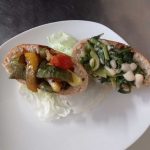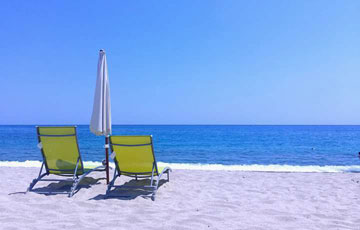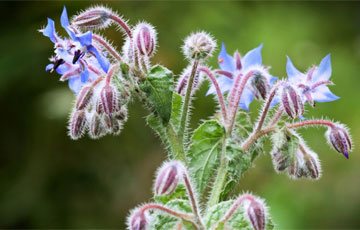-
Traditional Calabrian food
The Calabrian tradition is closely linked to its typical dishes. Here is a list of some traditional dishes of Calabrian culture.
Do you want to know more about traditional Calabrian food?
Take part in our gourmet tour Homemade scilatelle: they are a typical first dish that adorns the Sunday table of most Calabria. It was specially prepared by grandmothers in war time, when they could remedy water and flour, the only ingredients useful to make this dish. The term “scilatelle” derives from the term “catenary” dialectical “scroll” indicating the movement that is made with the ferret to prepare the pasta. It is usually seasoned with pork sausage because, with tomato paste only, the scottlers would slip.
Homemade scilatelle: they are a typical first dish that adorns the Sunday table of most Calabria. It was specially prepared by grandmothers in war time, when they could remedy water and flour, the only ingredients useful to make this dish. The term “scilatelle” derives from the term “catenary” dialectical “scroll” indicating the movement that is made with the ferret to prepare the pasta. It is usually seasoned with pork sausage because, with tomato paste only, the scottlers would slip.
This is the traditional receipt: https://www.torresantantonio.it/handmade-scigliatelle-recipe/Moglie e marito: typical of the caterisana tradition is made up of 2 slices of eggplant filled with ham and cheese and then blanched to create a single block.
‘Nduia: it is one of the most famous typical Calabrian products because it is a salami spread by the soft and creamy consistency, the intense scent, the very spicy flavor and the dark red color, due in the presence of the chili.
Marmellata di cipolle rosse (red onion marmelade): excellent with seasoned cheeses but also with roast pork roasts. An unmatched combination is with Pecorino, but also with fresh ricotta or salty cheese.
Carciofini selvatici (wild artichoke): they are spontaneous like wild horses, but only the upper part of the plant is used, where the flower is enclosed, surrounded by strong spines inside which the artichoke is contained. The groove is very long and laborious, so the fruits with delicate flavor are very rare and valuable. A top-class product of our culinary tradition, it’s ideal as an appetizer.
Lagane e ciciari ara cusentina: Poor dish that comes from afar, light dishes are among the first types of pasta in ancient texts: similar to noodles, but mixed only with water and flour, are cooked in salted water, and then seasoned with a sautéed with oil, garlic and chili peppers and chickpeas, cooked separately.
Pasta and patate ara tijeddra: it is the simple version of pasta ‘ncasciata or pasta to lu furnu, where come into play salami, boiled eggs, meat, caciocavallo and provola. Here, however, we find only pasta, potatoes, gravy, cheese and bread crumbs. The characteristic of this dish is that the ingredients are cooked together with raw, first on the fire, then with a brief pass in the oven, to grate the whole with a nice crust crunchy.

Maccheroni col ferretto (macaroni with iron): it’s fresh pasta of the southern regions, based on durum wheat semolina and water. The iron, from which they are named, is the tool used today for the preparation of this plate. In ancient times, to create the hole of this pasta format, a small juniper was used to make it square. The macaroni are seasoned with very rich sauces such as beef, pork or goat, or with the famous nduja.
Licurdia: Poor dish, this soup can contain different vegetables, such as scarola, beets, asparagus or carrots, depending on the area where it is prepared. But the main ingredient is the red onion of Tropea, the absolute protagonist with its strength and sweetness. The vegetables are cooked with lard and water for several minutes, once disfatte and become a succulent cream, they are placed in a plate, over slices of abrasive bread. With chili and pecorino to close.
Frittole e curcuci: real street food is prepared in the street, in front of the butchers. This dish is the further proof that “the pig does not throw away anything”. In large pots, generally copper, lined with rind, after having made fat loose well, throwing parts of the neck, cheek, pimples, muzzle, tongue, ears, belly and all other poor parts pork hard to put in other preparations. After a slow and long cooking (from 6 to 8 hours), you will have a meat fatty and so soft and tender. The small pieces of meat remaining on the bottom of the pot, the sugna and the rind, once solidified, are retrieved and taken on the name curcuci (something like chicks). They can be stored and used to flavor other dishes such as vermicelli or polenta with broccoli.
Mazzacorde alla cosentina: and after the pig, the lamb. Also in this dish are retrieved the less noble parts of the animal: lung, spleen, heart, tripe, grate are coarsely chopped and wrapped in lamb buds. After a short dip in oil and onion, add tomatoes, laurel and other herbs. They accompany with peppers and roasted potatoes; for a second dish among the most traditional and gourmands of this land.
Stoccafisso alla Mammolese: here we talk about dried fish, a part of the diet of the less well-off social classes that could not afford the fresh fish. In Calabria, stew is part of a myriad of recipes: it is prepared with mushrooms, beans, salad with lemon and parsley and in many other ways. But the most important one remains the stomach of Mammola: in this country of Reggio province, famous for its craftsmanship of this product, dried cod found in water is cooked with tomato sauce, potatoes, peppers and olives. Since 1979, in the medieval village of the town, on August 9 there is a festival dedicated to this dish.
Mostaccioli: originally from Soriano Calabro, but now spread throughout the region, are dry, hard and compact biscuits, prepared with honey and flour and sometimes enriched with hot must. The masters of the masters can imitate animal, floral and anthropomorphic forms and decorate their creations with colorful foil paper, creating real works of art. If you are in Calabria and are about to buy one, there is probably a party holiday around. They are cakes typical of fairs, fairs and patron saint, Easter and Christmas celebrations.
 Buggia conzata: pocket of bread filled with sauce typical of the lower Ionian of Catanzaro.Usually it was filled with poor condiments such as vegetables, offal, tomatoes. In recent years the condiments have been enriched by creating more noble ones such as black pig ragù, chickpeas and cod, cod entrails, ‘nduia and burrata.
Buggia conzata: pocket of bread filled with sauce typical of the lower Ionian of Catanzaro.Usually it was filled with poor condiments such as vegetables, offal, tomatoes. In recent years the condiments have been enriched by creating more noble ones such as black pig ragù, chickpeas and cod, cod entrails, ‘nduia and burrata.













